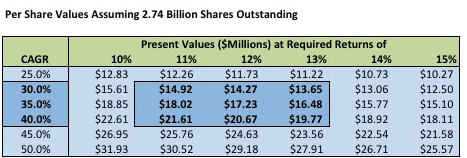
| June 13, 2012 | Issue #117-2 |
Valuing Facebook: Mercer does the math “As most everyone on the planet knows by now,” writes Z. Christopher Mercer (Mercer Capital), on his blog, Valuation Speaks, Facebook recently went public at $38 per share. At the time of the IPO, Google was trading in the general range of $600 to $615 per share, with an enterprise market capitalization of about $200 billion. Google generated $37.9 billion in revenue during 2011 and earned $12.3 billion net income, for an implied price/earnings ratio of 16.3x. By contrast, Facebook’s 2011 revenues were $3.7 billion and its net income was $1.0 billion. The IPO pricing was at $104 billion, with an implied P/E of 104x. “Has anyone done the math?” Mercer asked, in this first post. In a second post, Mercer did a little math. He performed a present value analysis, assuming that Facebook could grow at compound annual rates of between 25% and 50% for the next five years and that the shares would enjoy pricing at the price/revenue multiple of about 5x what Google enjoys. With growth rates between 30% and 40%, the analysis yielded prices ranging from $13.65 to $21.61 per share for a range of discount rates from 11% to 13%, as illustrated by this table:
Mercer did a little more math in his third and latest post. After factoring in the most recent analysts’ reports on the Facebook IPO, he once again used Google’s revenues, implied earnings ratios, and growth rates to show that Facebook would have to grow at 42% per year for the next six years to reach investor expectations. “I’ll ask the question I asked in the first post once again,” Mercer says: “Did anyone do the math?” Damodaran says to ditch the quantitative valuation models One of the biggest myths in business valuation, according to Prof. Aswath Damodaran (NYU Stern School of Business) is that "the more quantitative a model, the better the valuation." The first problem with such models is “input fatigue,” the professor said, during his recent three-day course on valuation for business executives (as reported in Business Insider). “What happens when it’s midnight and some beleaguered analyst has 76 inputs to enter? They might start to enter a few random numbers. If the model is big enough, it [the randomness] won't even matter to the final number.” To demonstrate the second problem with quantitative models, Damodaran tells about the time he planned to value a stock at $35, then found that an equity research analyst had recommended the same stock at $85, based on an in-house valuation model. “What did it do,” Damodaran asked the analyst, “sneak into your office in the middle of the night, value the company, and leave it on your desk?" What the analyst was really saying: “I have this really complicated model, [and] it asks me for numbers. I feed it the numbers, it asks me to go get a cup of coffee, and by the time I come back there's the answer.” “It’s amazing how with complex models you turn over responsibility,” Damodaran told his executive students. “Add detail to your model, but only if it adds value.” Webb wants you to apply the ‘3 keys’ in valuation reports Expanding on his recent comments at the ASA Tax Court Cases Symposium in Cerritos, Calif. (as reported in BVWire #116-4), Dennis Webb of Primus Valuations wants business appraisers to focus less on the “minutiae of valuation cases,” as interesting as those may be. “The problem is that we do not usually see our work from the user’s point of view,” he says, and very often end up with “frighteningly complex reports that are impossible to understand” by either the clients or the courts. Worse, if the IRS can’t figure it out, “they throw it out,” Webb says. If a Tax Court judge can’t follow an expert’s analysis, he or she will often disregard it and conduct his own. 7th Circuit explains the ‘gold standard’ of valuation While building a fast-food business, the owner promised that once he bought out his PE investors, he would distribute 50% of the equity to his top 20 managers. When he failed to do so, the managers sued for breach of contract. The federal district court found an agreement, but said the plaintiffs’ estimate of damages was “too simple.” From the buy-out price, they inferred the entire business was worth $48 million, of which they were entitled to half. But “it was impossible to derive the value of the whole firm from the amount paid for its holdings,” the court said, in dismissing the suit. Moreover, the amount the PE investors were paid depended on how much the business could borrow rather than its “true value.” The plaintiffs appealed to the U.S. Court of Appeals for the 7th Circuit. In an opinion written by Chief Judge Frank Easterbrook—a former University of Chicago law professor, who is widely respected for his creative applications of economic theory—the court found neither of the lower court’s valuation propositions was sound. “Indeed, each supposes that there is some measure of ‘true’ value that differs from what a willing buyer will pay a willing seller in an arms’-length transaction.” “Yet that is the gold standard of valuation,” Judge Easterbrook wrote. “The value of a thing is what people will pay.” The price a willing buyer and seller agree on “is the value of the asset,” he said, with repeated emphasis. “The judiciary should not reject actual transaction prices when they are available.” In remanding the case, the learned judge also pointed out the “real problems” with the plaintiffs’ calculations (which may have them scrambling to find a damages expert). Read the complete digest of Malik v. Falcon Holdings, LLC, 2012 U.S. App. LEXIS 5336 (March 14, 2012) in the July 2012 issue of Business Valuation Update. The court’s decision will be posted soon at BVLaw. Yeanoplos and Dietrich discuss industry-specific COC Tomorrow, June 14, join Kevin Yeanoplos (Brueggeman and Johnson Yeanoplos) and Mark Dietrich for Industry-Specific Issues in Cost of Capital Determination, an in-depth examination of how industry-specific factors such as risk, capital structures, competition, regulation, and other key attributes and influences affect cost of capital determinations, generally, with particular focus on the construction and healthcare industries. Winning students say valuation without BVR data is like 'an accountant teaching astrophysics' The winner of the first annual BVR/SPU Valuation Challenge was “hard to call,” says Prof. Herb Kierulff, who reported on the competition held May 31 at the School of Business and Economics, Seattle Pacific University. The four student teams were judged by three senior managers from Moss Adams: Clayton Cafferata, Wayne Fjeld, and Diane Anderson Murphy. "We were impressed with how poised the teams were and the professionalism of their presentations,” one of the judges said, after the competition:
The students were just as enthusiastic in their feedback. “BVR was a tremendous help in our forecasting,” wrote one. “Without access to this specific data, there is no doubt in my mind that our valuation would have had about as much credibility as an accountant teaching astrophysics without any prior knowledge.” At the end of the day, the student team of Johnathan Koc, Anders Isaksen, Cody Nesbitt, and Matthew Norgren took home the prize. “Thank you BVR for your considerable contributions to our joint efforts to prepare students for the challenges they will face in the world of finance,” Professor Kierulff writes. “Because of the success of the first, we are at work planning the Second Annual BVR/SPU Valuation Challenge next year, and plan to invite 12 other universities to join us in the competition.” Stay tuned … And in the meantime, if you’re interested in championing a similar learning experience for local university finance students that harnesses the power of BVR data, contact Adam Manson, BVR’s financial research manager, at adamm@bvresources.com BMI's gold standard international industry forecast reports now available through BVR Via a new partnership, BVR now offers Business Monitor International's (BMI) country-by-country international industry forecasts. For nearly every country in the world—in emerging as well as established markets—the highly regarded BMI reports cover key industry sectors from agribusiness to shipping, defense to real estate, food and drink to pharmaceuticals and healthcare. BMI analysts update over 1,000 country reports daily to track the dynamics of supply and demand, from both regional and global economies. In addition, BMI integrates its five- and 10-year country forecasts with country-by-country risk analysis and its proprietary country-comparative risk-reward metric, the Business Environment Rating. The BMI models—which use multilinear regression analysis of industry-specific and macroeconomic variables—are particularly helpful to support international cost of capital and risk measurement decisions. To find out more and to download a free sample report, click here now. APB asks for experts on contingent consideration The Appraisal Practices Board is seeking subject matter experts (SMEs) for its fourth working group on valuing contingent consideration. At a minimum, the selected panel will gather and cite relevant research on the topic from existing literature and publications. For more information on the background and qualifications of SME candidates, please see the application at The Appraisal Foundation website. 30% of CFOs see transfer pricing as the greatest risk Among 60 chief financial officers of companies with more than $1 billion in annual revenues, nearly one-third (30%) said that transfer pricing was their biggest tax-related challenge and risk, according to a new survey by Alvarez & Marsal (as reported by WSJ.com). Only four CFOs reported spending most of their time—and money—on transfer pricing issues, but the prevalent concern among respondents helped push transfer pricing to Number 2 on the survey of risk, just behind global compliance. Chair of IFRS trustees says U.S., China need to get on board “In the last 10 years we have gone from almost no economies using international accounting standards, to a world where companies in more than 100 countries … are required or permitted to use IFRS,” said Michael Prada, chair of the IFRS Foundation Trustees, in addressing the 2012 IOSCO conference last month in Beijing, China. In addition to European Union members, more than two-thirds of G20 countries are now required to use IFRSs, Prada said. “In the last two years alone we have seen Brazil, Canada, Korea, Mexico and Russia all require the use of IFRS, in full and without modification.” Almost half of global Fortune 500 companies also now report using IFRS. “Therefore, it is clear today that the IFRS Foundation fits the three main criteria that any international standard-setter should meet,” Prada said:
“I think we can safely say that IFRSs have now achieved critical mass as international standards, and are here to stay,” Prada said. “However, we cannot get the full benefit of those standards without the remaining major economies coming fully on board,” including China, Japan, India, and the United States. More excerpts from his remarks, as reported by Inaudit.com, are available here. Experts distinguish lost profits from lost business value In claiming economic damages, a business may seek to recover either lost profits or lost value—but it can’t seek both. Its choice of the exclusive remedy will often depend on the circumstances of the case as well as the applicable law, and not many courts will allow a “second bite at the apple” if financial experts and attorneys get it wrong. To make the right decision and understand its ramifications in the litigation and valuation process, register for Part 11 of BVR’s Online Symposium on Litigation & Economic Damages, "Lost Profits v. Lost Business," featuring Edward McDonough and Laureen Ryan (both Alvarez & Marsal) on June 19.
To ensure this email is delivered to your inbox, please add editor@bvwire.com to your e-mail address book. We respect your online time and privacy and pledge not to abuse this medium. To unsubscribe to BVWire™ reply to this e-mail with 'REMOVE BVWire' in the subject line or use the link below. This email was sent to %%emailaddress%% Copyright © 2012 by Business Valuation Resources, LLC |
|




